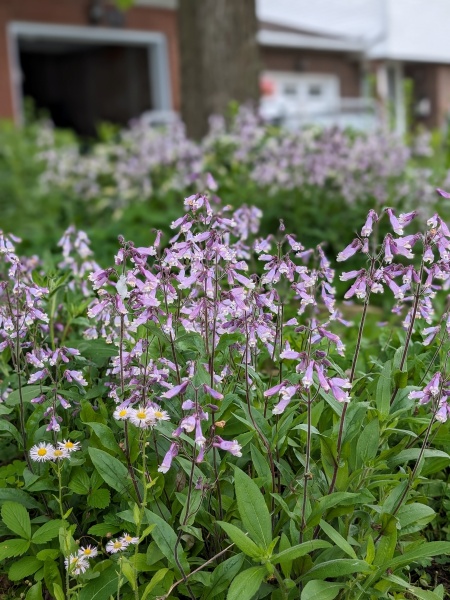
Source: Donna Bos
Penstemon hirsutus
Hairy Beardtongue
Penstémon hirsute
Synonyms
northeastern beardtongue
Seeds in stock
Available at table Mixed Sun, Dry
Available at table Mixed Sun, Dry
We currently accept seeds for this plant
Bloom Colour: Purple
Bloom Period: May - Jun
Max Height: 2.0 feet
Max Width: 1.0 feet (spreads by rhizome)
Light Condition:
 More than 6 hours of direct sun a day
More than 6 hours of direct sun a day
 More than 2 or 3 hours but less than 6 hours of direct sun a day
Soil conditions:
More than 2 or 3 hours but less than 6 hours of direct sun a day
Soil conditions:
 Tolerates dry soil condition
Tolerates dry soil condition
 Tolerates medium soil condition
Tolerates medium soil condition
 More than 6 hours of direct sun a day
More than 6 hours of direct sun a day
 More than 2 or 3 hours but less than 6 hours of direct sun a day
More than 2 or 3 hours but less than 6 hours of direct sun a day
 Tolerates dry soil condition
Tolerates dry soil condition
 Tolerates medium soil condition
Tolerates medium soil condition
Lifespan:
Perennial
plants that will that come back year after year
Gardener Experience:
 Suitable for beginner gardeners
Suitable for beginner gardeners
 Does not spread uncontrollably
Does not spread uncontrollably
 Easy to germinate
Easy to germinate
 Self-seeding
Self-seeding
 Suitable for beginner gardeners
Suitable for beginner gardeners
 Does not spread uncontrollably
Does not spread uncontrollably
 Easy to germinate
Easy to germinate
 Self-seeding
Self-seeding
Landscape Uses:
 Suitable for rock gardens
Suitable for rock gardens
 Suitable for Right of Way gardens
Suitable for Right of Way gardens
 Suitable for container garden
Suitable for container garden
 Suitable for school gardens
Suitable for school gardens
 Tolerates boulevard garden conditions
Tolerates boulevard garden conditions
 Suitable for rock gardens
Suitable for rock gardens
 Suitable for Right of Way gardens
Suitable for Right of Way gardens
 Suitable for container garden
Suitable for container garden
 Suitable for school gardens
Suitable for school gardens
 Tolerates boulevard garden conditions
Tolerates boulevard garden conditions
Ecological Benefits:
No ecological benefits information available.
Tolerates:
 Tolerates salt conditions
Tolerates salt conditions
 Deer resistant
Deer resistant
 Rabbit resistant
Rabbit resistant
 Tolerates foot traffic around the plant
Tolerates foot traffic around the plant
 Tolerates limestone conditions
Tolerates limestone conditions
 Tolerates sandy conditions
Tolerates sandy conditions
 Tolerates salt conditions
Tolerates salt conditions
 Deer resistant
Deer resistant
 Rabbit resistant
Rabbit resistant
 Tolerates foot traffic around the plant
Tolerates foot traffic around the plant
 Tolerates limestone conditions
Tolerates limestone conditions
 Tolerates sandy conditions
Tolerates sandy conditions
Special Features and Considerations:
Plant Location
Native to Ottawa region: Yes
Distribution according to VASCAN

Ephemeral
Native
Introduced
Excluded
Extirpated
Doubtful
Absent
Thrives in Ecozones
- Atlantic Maritime
- Mixed Wood Plains
Ecological Benefits
Butterflies Supported by Penstemon hirsutus
- Euphydryas phaeton (Baltimore Checkerspot)
Specialized Bees Supported by Penstemon hirsutus
No bee data available for this plant.
Plants that grow in similar conditions, that bloom at the same time.
Complementary Plants
- Antennaria neglecta
Field Pussytoes
Antennaire négligée - Erigeron philadelphicus
Philadelphia Fleabane
Vergerette de Philadelphie - Geum triflorum
Prairie Smoke
Benoîte à trois fleurs - Glyceria canadensis
Canada Mannagrass
Glycérie du Canada - Packera paupercula
Balsam Groundsel
Séneçon appauvri
Substitute For Non-Native Plants
- Penstemon digitalis (Foxglove)
- Lamium (Dead nettle)
- Ajuga reptans (Bugleweed)
- Buddleia (Butterfly Bush)
- Delphinium (Delphinium)
- Salvia (Non-Native Sage)
- Aquilegia (Columbine Cultivars)
- Lamium galeobdolon (Yellow Archangel)
- Baptisia (False Indigo)
- Impatiens balsamina (Impatiens Balsamina)
Sowing Information
Download Seed Envelope Labels (PDF)
- Sowing depth: Surface sow
- Sow by February
- Stratification duration: 60 days
- Self-seeding
Harvesting and Seed Sharing
- Harvest start month: September
- Harvesting indicator:
- Pods are brown and crisp and starting to open
- Seeds are dark and tiny stem attaching to the main stem is brown
- Seeds easily fall off pod when shaken
- Little stem connecting the pod to the main stem is brown (not green)
- Harvesting:
- Cut stem (including pods), let air dry in paper bag, then shake seeds off after a few days
- Seed viability test:
- No test needed before donating
- Packaging measure: Half of one, 1/32 teaspoon
- Seed storage:
- Air dry in paper bag or open container, for a few days until crisp
- Shake seeds to move them once in a while to prevent molding
- Cultivar: Yes, do not donate unless you know source, and there are no known cultivars in your garden or at proximity
- Harvesting video: Watch here
Toxicity Notes
Inadequate information on toxicity found but might be toxic.


 Canadensis
Canadensis
